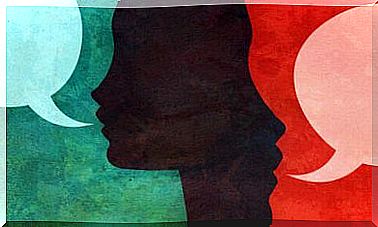Attraction Between People: Why Does It Exist?

Why is there attraction between people? This is a question we often ask ourselves. Well, research on this phenomenon is much more numerous than on other topics. Perhaps because it is easier for researchers to induce this feeling between two strangers than it is to foster and observe a long-term loving relationship.
Elizabeth Barrett Browning, nineteenth-century poetess, wrote: “How do I love you? How I love you? Let me count the ways “. With these verses he expressed his feelings on a central theme of life and on a very important research object in social psychology: love and affection.
Factors that affect the attraction between people
Traditional studies provide a wealth of data about the factors that trigger the initial attraction between two people. Among the most important factors taken into consideration by social psychologists we find:
Nearness
If you live in a condo or student boarding school, think about the friendships you have made since you moved to this place. It is very likely that best friends are chosen from those who live or have lived near you.
This is one of the most well-established findings in the literature on interpersonal attraction. As we can easily verify, closeness leads to affection (Festinger, Schachter & Back, 1950).

Simple exposure
Repeated exposure to a person is usually enough to generate attraction. It is interesting to note that repeated exposure to any stimulus (be it a person, a painting, a song or whatever) almost always increases the stimulus of pleasantness (Zajonc, 1968).
The process of becoming familiar with a stimulus can evoke positive feelings. These familiar-generating feelings are then transferred to the stimulus itself.
Of course, there are exceptions. When initial interactions are extremely negative, repeated exposure has little chance of making us a more pleasant person. On the contrary, the more we are exposed to that person, the more we will hate them.
Similarity
Popular wisdom says that “whoever looks alike takes on himself”. But it also says that opposites attract. Which of these two statements is more correct? Social psychologists have come to a clear verdict.
We tend to love those who look like us. Discovering that the attitudes, values or traits of others are similar to ours favors the birth of affection. The more similar a person is to us, the more attractive he is to us (Byrne, 1969).
One of the reasons that similarity increases the likelihood of interpersonal attraction is that we assume that people with similar attitudes to ours value us positively. Due to the strong reciprocity effect, knowing that someone is judging us positively encourages us to notice the person in question more.

Need for complementarity
We all know some exceptions to the rule of similarity that generates attraction. There are couples who appear to be quite different in personalities, interests and attitudes. Nonetheless, the two partners are completely fascinated by each other.
Social psychologists explain that in some cases people are attracted to individuals other than themselves because they satisfy some of their needs. According to this reasoning, we are attracted to the people who satisfy the greatest number of our needs.
A dominant person, for example, might be looking for a submissive partner. And conversely, a submissive person may be looking for someone to dominate them. Although the differences lead one to think that they are incompatible, within the relationship they satisfy each other’s complementary needs.
Physical attraction
For most people, the equation “beautiful equals good” is indisputable. Physically attractive people have always been more popular than those who are not, all other factors being equal.
This discovery contradicts the values that most people claim to possess. However, it appears to be especially true in childhood. And this criterion is preserved until adulthood.
In fact, physical attraction may be the most important element in generating initial affection. However, its influence tends to diminish as you get to know each other better.

While physical attraction offers many benefits, it also has a downside. If physical beauty in a man makes a better impression in the workplace, in women it can hinder the achievement of managerial positions.
The cause of this phenomenon is the common (albeit unfounded) stereotype that attractive women are only successful by virtue of their physical appearance.
It remains true that looking good is, in general, an advantage in social interactions. It is a very powerful factor in determining who attracts people and what kind of social life one leads.
The elements we have just seen are not the only ones that influence the attraction between people. In a study of about 40,000 individuals, the qualities most valued in a friend were: ability to keep secrets, loyalty, warmth and affection, followed by supportive skills, sincerity and a sense of humor.









